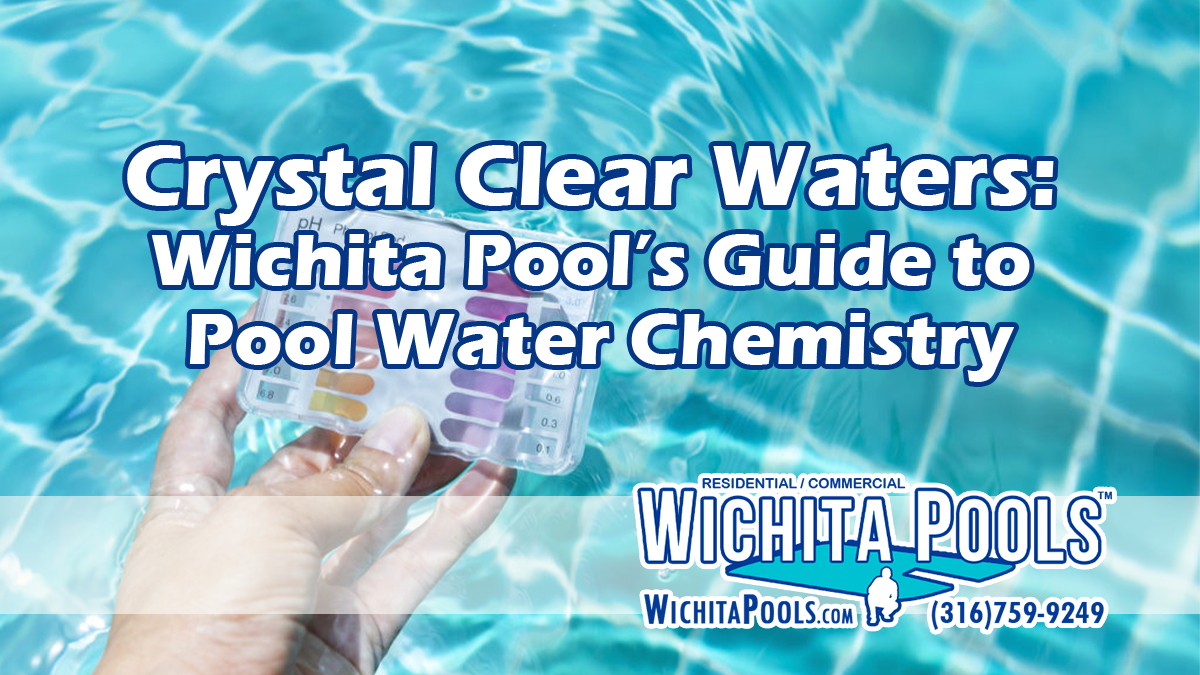Maintaining a sparkling and inviting swimming pool requires more than just a clean surface. Behind those crystal-clear waters lies a delicate balance of pool water chemistry. At Wichita Pools, we’ve been perfecting this balance for over 20 years, and now we’re here to guide you through the process step by step.
Whether you’re a DIY enthusiast or prefer leaving it to the experts, our comprehensive guide will empower you to manage your pool water chemistry effectively.
Step 1: Understanding the Basics of Pool Water Chemistry
Before diving into chemical compounds and pH levels, let’s start with the fundamentals:
- pH Levels: pH measures the acidity or alkalinity of the water on a scale of 0 to 14. A pH of 7.4 to 7.6 is ideal for pool water, ensuring comfort for swimmers and optimal effectiveness of chemicals.
- Sanitizer Levels: Chlorine and other sanitizers keep the pool water free from harmful bacteria and contaminants. Maintain a sanitizer level of 2.0 to 4.0 parts per million (ppm) for safe swimming.
- Alkalinity: Total Alkalinity (TA) acts as a buffer for pH levels. Aim for a TA range of 80 to 120 ppm to prevent drastic pH fluctuations.
- Calcium Hardness: This refers to the concentration of calcium in the water. A range of 200 to 400 ppm is suitable to prevent scaling or water becoming too corrosive.
Step 2: Testing Your Pool Water
Regular water testing is crucial to ensure balanced chemistry. Test your water at least once a week and after heavy rainfall or pool usage. More people in your pool means more disruption in water chemistry. Quick and easy DIY test kits are readily available at all pool stores, though professional pool maintenance teams like Wichita Pools, have advanced equipment for extremely precise measurements.
Step 3: Adjusting Pool Chemistry
Based on your test results, you might need to make adjustments:
- pH Adjustment: Use pH increasers or decreasers to maintain the optimal pH level. Remember, slight adjustments are key to avoid overcorrection.
- Sanitization: If your sanitizer levels are low, add the appropriate amount of chlorine or other sanitizers. Shock the pool when necessary to eliminate bacteria buildup.
- Alkalinity and Calcium: For alkalinity and calcium adjustments, pool-specific chemicals are available. Follow manufacturer guidelines for accurate dosages and always make slight adjustments.
Step 4: Routine Maintenance
- Skimming and Cleaning: Regularly remove leaves, debris, and bugs from the pool’s surface. Clean the skimmer baskets and pool filters to ensure proper water circulation.
- Brushing and Vacuuming: Brush the pool walls and floor to prevent algae growth. Vacuum the pool floor to remove dirt and sediment.
- Backwashing: If you have a sand filter, backwash it as needed to maintain efficient filtration.
Step 5: Professional Expertise from Wichita Pools
While managing your own pool chemistry can be satisfying, we understand that life gets busy. That’s where Wichita Pools steps in. Our seasoned professionals have over two decades of experience in pool construction, service, and maintenance. We offer a worry-free solution by handling your pool’s chemistry and upkeep on a weekly basis, ensuring you have more time to relax and enjoy your pool. Want to enroll in our weekly maintenance program? Contact us.
Maintaining your pool water chemistry doesn’t have to be a daunting task. With a solid understanding of the basics, regular testing, and a touch of expert assistance, you can achieve those inviting crystal-clear waters. Whether you choose to take the DIY route or let Wichita Pools handle it, the ultimate goal remains the same: a safe and enjoyable swimming experience for you and your loved ones.


